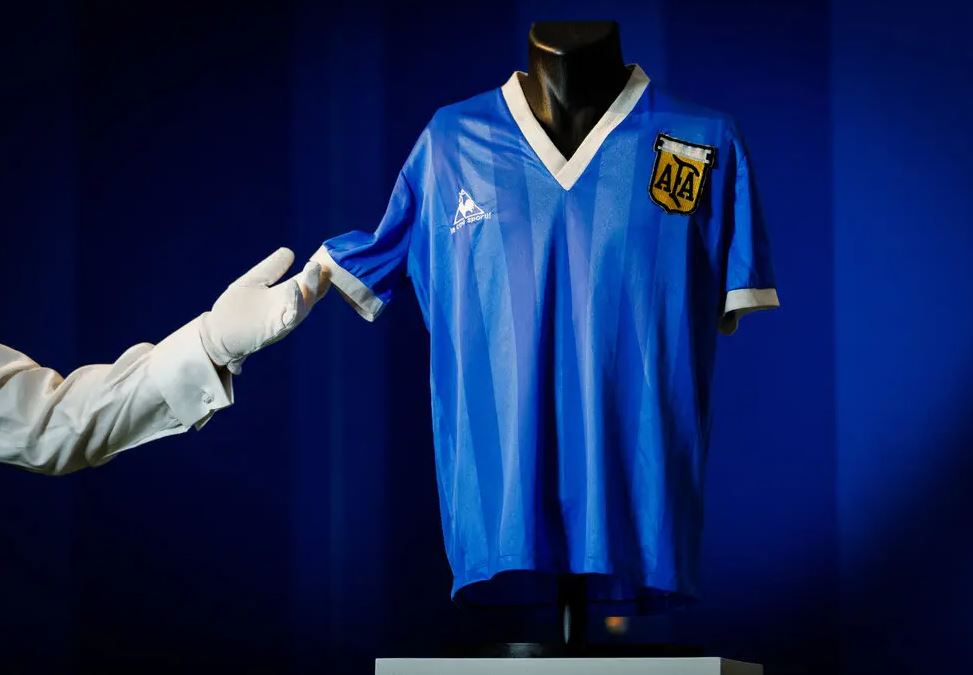Steve Hodge of England’s national soccer team looped a pass to his goalkeeper that was intercepted by Diego Maradona of Argentina, allowing Maradona to score one of the most infamous goals in the history of the sport against Hodge’s squad during the quarterfinals of the 1986 World Cup.
It would go on to become one of the most discussed goals in the history of professional soccer: In a fast-paced action, Maradona was able to get away with palming the ball with his left hand, and he subsequently invoked “the hand of God” to explain what had happened.
The winner of the conversation seems to be up for debate at this point. Despite the fact that Maradona proceeded to the finals and won, Hodge was awarded a jersey, complete with dried perspiration, which he recently sold for about $9.3 million at a Sotheby’s auction, which is thought to be the highest price ever paid for a piece of sports memorabilia in history.
Sotheby’s announced the sale on its Twitter account on Wednesday. It did not identify who was purchasing the item. In a press release, Sotheby’s reported Hodge as saying that it has been a “privilege” to have the jersey on display in the National Football Museum in Manchester, England, for the last 20 years.
And he went on to say, “The Hand of God jersey has significant cultural significance to the footballing world, as well as to the people of Argentina and the people of England, and I’m certain that the next owner will feel tremendous satisfaction in having the world’s most famous football shirt.”
Leila Dunbar, an appraiser specialising in pop culture products, said the transaction was representative of the recent surge in the value of sports memorabilia in general.
Maradona, who is widely regarded as one of the greatest soccer players of all time, along with Pelé, was renowned for his scrappiness and spurts of brilliance on the field. His performance in the second half of that quarterfinal encounter against England, which took place in Mexico City, exemplified both of those attributes.
Four minutes later, Maradona scored the goal that soccer fans voted as the “World Cup Goal of the Century” in a poll conducted by the sport’s governing body, FIFA. With his team’s half of the field in his back pocket and his feet dribbling backwards for a split second, then sprinting one moment and slowing to a prance the next, he travelled 70 yards and around five English players before blazing past the team’s goalie and booting in the winning goal in the blink of an eye before tumbling over the sidelines.
In a statement to Agence France-Presse, Maradona’s oldest daughter, Dalma Maradona, claimed that her father had given Hodge the shirt he had worn during the match’s rather uneventful first half. The legitimacy of the jersey had been called into doubt a few weeks before the match.
As the creator and editor of Sports Collectors Daily, a website dedicated to the sporting goods sector, Rich Mueller said that the transaction was “the highest amount he had ever heard someone pay for memorabilia, whether at an auction or in a private sale.”
Recent record-breaking sporting goods sold at auction include a Babe Ruth jersey, which sold for $5.6 million in June 2019, and a book that outlined the foundation ideals of the modern Olympics, which sold for $8.8 million in December 2019.
A Jackie Robinson jersey from 1947, his rookie season, sold for over $2 million in 2017, while a Jackie Robinson jersey from 1950, his last season, sold for more than twice that amount — around $4.2 million — in 2018. It is anticipated by Ms. Dunbar that a Robinson jersey that goes on sale today might fetch between $10 and $20 million dollars.
In the words of Brahm Wachter, the head of streetwear and contemporary collectibles at Sotheby’s, “people are recognising that these artefacts can be valued as if they were works of art.”

